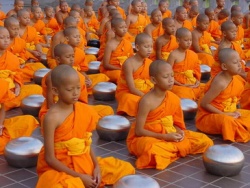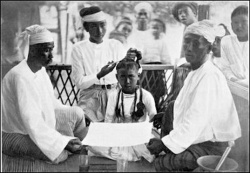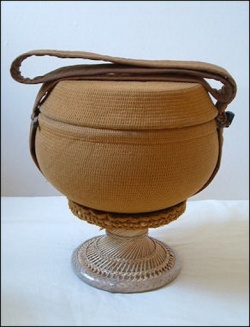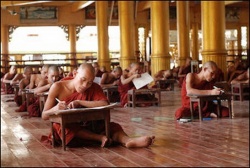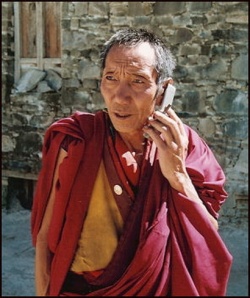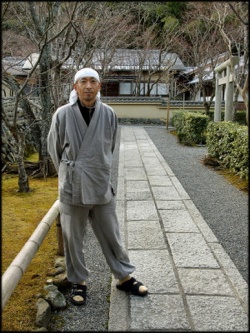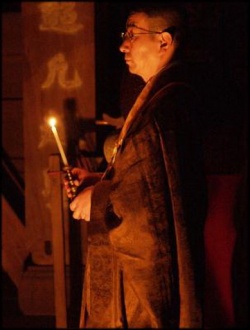Buddhist Monk Initiations
by Jeffrey Hays
The vow taken by Theravada monks is essentially an embrace of the Three Jewels— Buddha, Dharma (Buddha's teachings), and the Sangha (the brother hood of monks) with the vow: "I take refuge in the Buddha, I take refuge in the law, I take refuge in the Community of monks."
The first five ascetics who became the first monks under The Buddha were joined by 55 others. They together with The Buddha are known as the 61 arhants. The were ordained by The Buddha by repeating the simple phrase: “Come monk; well-taught in the Dharma; fare the attainment of knowledge for making a complete anguish.” Others that came later were ordained after cutting their hair and beard, donning a robe and uttering three times: “I go to The Buddha for refuge, I go to Dharma for refuge, I go to the sangha for refuge.” This ritual remains the basis of the Theravada monk ordination process today.
Upon ordinations a monks is given robes (often three robes, an inner, lower and outer ones), and simple possession such as a cup, bowl, razor, filter (for keeping out insects out their drinking water), an alms bowl and an umbrella.
Monks and nuns in some Buddhist sects have five scars on their arm made with burning incense to remind them of the five basic moral prohibitions (the Panch Sila) which they vowed to avoid: killing, lying, stealing, adultery and drinking alcohol. After the marks are made the burns are cooled with watermelon rind.
Buddhist Monk Initiation Ceremony
In countries where Theravada Buddhism predominates, the novice monk initiation ceremony is an important rite of passage for young boys. Conducted when a boy is around 13 years year old, the event includes the offering of gifts to the Buddhist clergy at the temple where the ceremony is held, a feast hosted by the boys family, a formal head shaving ritual, and lots of prostrating by family members to the boy to symbolize the elevation to adulthood and the boy's new position as a son of Buddha.
The parents gain merit by offering their son to Buddha and the grander the ceremony the more merit they earn. Elaborate ceremonies sometimes last several days and have musical performances, singing and chanting of poems that recall episodes of Buddha’s life.
While the boy’s head is being shaved, he is instructed by an abbot or senior monk to meditate on the action, contemplate its meaning and repeat thing like, "They are of this body, hair of the head, hairs of the body, nails, teeth and skin, which are unclean, abominable, filthy, lifeless and insubstantial." The hair of a novice monk is considered sacred. It is not allowed to touch the ground and is collected in a cloth spread out by the parents.
After the head is shaved the boy turmeric and saffron powder is rubbed into the scalp and the newly anointed monk is given a robe and sent off to the monetary for several weeks or months. After that time he returns to a normal life.
Buddhist Monk Code of Behavior
Monks follow the model of the Buddha who traded in his clothing for simple robes. They live as simply as possible and follow a strict code which includes refraining from stealing, drugs, alcohol, sex, entertainment, dancing, swearing, lying, sacrilegious acts, sex, and making money. The code includes the five basic commandments of Buddhism (the Panch Sila), plus three to five additional restrictions which may include prohibitions against things like eating after noon, sleeping on high beds and wearing jewelry or garlands.
Buddhist monks make a vow to give up all possessions. They are allowed to possess three robes and own a handful of personal items. Monks shave their heads and faces to discourage vanity and symbolize the renunciation of the worldly life. They also are supposed to eat only vegetarian food. The public supplies them with food and money for housing and medical care.
In Southeast Asia monks must follow 227 vows. In many places even touching a woman is taboo. Offenses can result in a reprimand, suspension or expulsion from the monastery. Many of the rules are similar to those followed by Hindus Sadhus (holy men).
Most monks are novices. If all goes well they are ordained as full monks after two years or so. Novice monks study of the sacred texts in Pali and Sanskrit (the original Buddhist texts were written in these languages);engage in debates subtle points of Buddhist theology such as whether or not a rabbit has a horn and whether or not past and future events can be described as real. Young monks also have to perform chores around the monastery like collecting water and the sweeping floors. In their free time they often monkey around, or play cricket, soccer or baseball.
To earn merit on Buddha birthday some monks walk around and around their monasteries the entire day, carrying heavy wooden bound prayer books. Many classrooms in monastery colleges are outfit with buckets. If a monk can't remember a text he was supposed to recite he has to wear a bucket of water around his neck until he gets it right.
Buddhist Monk Duties
The life of a monk is not all quiet meditation, teaching, praying and studying. Monks preside over the important events in a person's life. They bless births, consecrate weddings, interpret the future, cure sickness and cremate the dead. A Buddhist's social life often revolves around festivals held at temples and monasteries.
Monks have traditionally taught reading and writing to young girls and boys, and morals, philosophy and meditation to older students. Today, they often teach poor children whose families can’t afford regular school. They also offer courses in architecture, sculpture, painting, carving, massage and brick-making. Some monks provide counseling for people with problems. Other specialize in healing, folk magic and fortune telling.
Monks also take part in public works projects and help villages build dams and irrigation projects, build schools and temples, preside over government events, bless dignitaries and projects, and preside over shop openings, new car purchases and moving into a house.
In some places, monks are called in to settle family and property disputes and offer advice and consul to people who are depressed, contemplating suicide or suffer from mental illness. They also reform juvenile delinquents and cure drugs addicts of their affliction. Buddhists can seek the moral and spiritual advice from a monk the same way Catholics seeks help from a priest. Many people also seek out monks for advice on matters usually associated with fortunetellers.
See Drug Treatment
Buddhist Monk Attire
Monks generally have shaved heads and are prohibited from wearing anything other than their robes, which consists of three garments: a bed sheet-size out garment, a similar-size inner garment and a loincloth-like underpants. Wearing clothing made from animal skin and leather is taboo. Monks are not even supposed to ride on animals.
Monks sometimes meditate on their robes, chanting, "I wear these robes to avoid cold, to avoid heat, to prevent the bites of insects, mosquitos, snakes and bugs, to shelter from wind and sun, and to cover the shameful parts of my body." The robes can be positioned in a number of ways depending on the weather. Hoods, for example, are fashioned when the sun is really bright. Many go barefoot though most wear sandals.
The robes worn by monks vary in color from place to place. Monks in Thailand and Cambodia wear yellow-orange or saffron robes; those in Tibet, Bhutan and Mongolia were maroon or wine-colored robes; monks in Korea wear grey; monks in China and Japan wear brown and yellow. Sometimes monks don black robes when they preside over a funeral or perform rites for the dead.
The daily routine of Buddhists monks varies from sect to sect, but the patterns are similar. Most monks wake up early, usually around 3:00am, live simply, do chores around the monastery and spend many hours meditating and praying. Monks sleep in dormitories, often on wooden beds with little or no privacy. Most of their duties and chores are performed in the main prayer hall. They generally eat before they meditate. Temple meals are vegetarian with natural spices such as pepper or powdered sesame.
Describing his experience at a Zen monastery journalist Patrick Smith wrote in National Geographic, "I ate an austere dinner of rice and fresh, cold vegetables. Under the watchful eye of a youthful priest-trainee, I spent 30 minutes at zazen meditation that evening. Before I could begin it took him that amount of time to get my position just right—legs properly crossed, hands correctly placed, head at the desired angle. Then I was to follow my thoughts wherever they led. I slept on a tatami mat on the floor."
The monasteries is most active after dawn or between 9:00am and 11:00am when chanting and prayers are being done. "At 3:30 the next morning," Smith wrote, "I was awakened and led to a room where row upon row of priests, kneeling on a vast spread of tatami, were softly chanting a Buddhist sutra. So the monastery began its day. It was cold and breakfast (as austere as dinner) was hours away; hunger gnawed at my attention, and my eyes wandered across the old plaster walls and the heavy ceiling beams, darkened by the smoke of countless sticks of incense...[Source: Patrick Smith, National Geographic September 1994]
In Theravada Buddhist societies in Southeast Asia, monks often spend the morning wandering from place to place in single file with a bowl, begging for food which they must consume before 12:00 noon. These monks are not allowed to eat anything for the rest of the day. Buddha himself wandered around with a begging bowl for a while and lived liked a monk.
The begging bowl is usually round, black and smooth and has a lid. An official of the Myanmar Religious Affairs Department told journalist Richard Ehrlich, "In the beginning of monastic history, monks picked up broken water jars discarded by housewives blackened them by baking them in a kitchen fire and converted them into alms bowls. But later on, Lord Buddha allowed the disciples to make new alms bowls."
During the morning begging ritual in Thailand, the monks walk through the streets with their begging bowls for 20 minutes or so. There is no talking, thanking, or eye contact. The monks accept the offerings, sometimes walking away silently, and sometimes bless the people who give them food. Male food givers often remove their sandals to show respect. Women are supposed to kneel. It is impolite to offer a banana with the tips still on.
Buddhist Monks, Prayer, and Meditation
Monks sit cross-legged in rows as they chant their prayers to the accompaniment of drums, bells and burning incense. Prayer and chanting sessions are usually held in private and lay people usually don't attend. These ceremonies are often held on a daily basis and sometimes they begin at three in the morning.
Meditating Zen monks cast their eyed downward, assume the lotus position, keep their backs straight and attempt to clear their mind so that "enlightenment will grow out of the state of nothingness." Novice monks who droop their head or fall asleep while mediating are whacked on the shoulder with a stick, by their instructors, who tell them to "Concentrate." [Source: Patrick Smith, National Geographic September 1994]
Many meditation centers off instruction to lay people and civil servants and teacher learn meditation from master during a three two to four week course. Some monasteries also give massages.
Buddhist Monk Mind and Body During Meditation
See Meditation
In Southeast Asia, women are not allowed to touch monks. A pamphlet given to arriving tourists in Thailand reads: "Buddhist monks are forbidden to touch or be touched by a woman or to accept anything from the hand of one." One of Thailand's most revered Buddhist preachers told the Washington Post: "Lord Buddha has already taught Buddhist monks to stay away from women. If the monks can refrain from being associated with women, then they would have no problem."
Buddhist monks in Thailand have more than 80 meditation techniques to overcome lust and one of the most effective, one monk told the Bangkok Post, is "corpse contemplation."
The same monk told the newspaper, "Wet dreams are a constant reminder of men's nature. " Another said that he walked around with his eyes lowered. "If we look up," he lamented, "There it is—the advertisement for women's underpants."
In 1994, a charismatic 43-year-old Buddhist monk in Thailand was accused of violating his vows of celibacy after he allegedly seduced a Danish harpist in the back of her van, and fathered a daughter with a Thai woman who gave birth to the child in Yugoslavia. The monk also reportedly made obscene long distance calls to some his female followers and had sex with a Cambodian nun on the deck of a Scandinavian cruise ship after he told her they had been married in a previous life.
The monk was also criticized for traveling with a large entourage of devotees, some of them women, staying in hotels instead of Buddhist temples, possessing two credit cards, wearing leather and riding on animals. In his defense, the monk and his supporters said that he was the target of "a well organized attempt" to defame him masterminded by a group of female "monk hunters" out to destroy Buddhism.
Greedy Buddhist Monks and Corrupting Influences
Monks sometimes wear Reebox running shoes under their robes and suck on popsicles and smoke cigarettes after the meditation sessions are over. In some monasteries where discipline is particularly lax they can bee seen drinking alcohol at festivals and possessing many more things than their ascetic life ascribes.
A Thai writer named Sulak Sivaraksa told National Geographic's Noel Grove: "Modern life has made virtuous existence very difficult, even for monks. A hundred years ago, monks handled many of the social responsibilities—hospitals, education, moral training. Now the rich go to government universities or to schools abroad. they are losing the Buddhist teachings, and the monkhood is losing its identity."
"Some monks," Sivaraksa said, "began smoking—calling it medicine—and taking drugs and opening bank accounts. The noble truths of Buddhism are being ignored, such as lack of greed and the importance of suffering and humility."
Buddhist monks in particular sects in Japan and Korea are allowed to get married and have children. In Japan, many earn six figure dollar incomes, drive fancy cars, smoke cigarettes and wear three piece suits. The situation has gotten so out of hand in Japan, where greedy monks have been accused of overcharging their customers for funerals, blessings and other services. A funeral mass, for example, averages about $1,500, and the presiding monk often get to keep 90 percent of the fee for himself. [Source: Quentin Hardy, the Wall Street Journal]
Monks and temples have been charged with undereporting their income on their tax returns; established temples sometimes franchise their name to new temples for $3,000 fees; and rich monks usually pass their temples down to their children like feudal lords. A monk at one temple, who earned about $100,000 a year, was fired after he punched out another monk who told him to clean a floor.
An American who spent a year in Japan studying the "deeper meaning" of Buddhism told the Wall Street Journal that "almost nobody knew anything about it." A monk at one temple told him "money is a pretty big part of it." Another told him that "people don't respect you unless you are successful. You've got to have a good car to show you've reached a state of holiness."
Greedy monks, See Thailand. , See Japan {{R}factsanddetails.com
